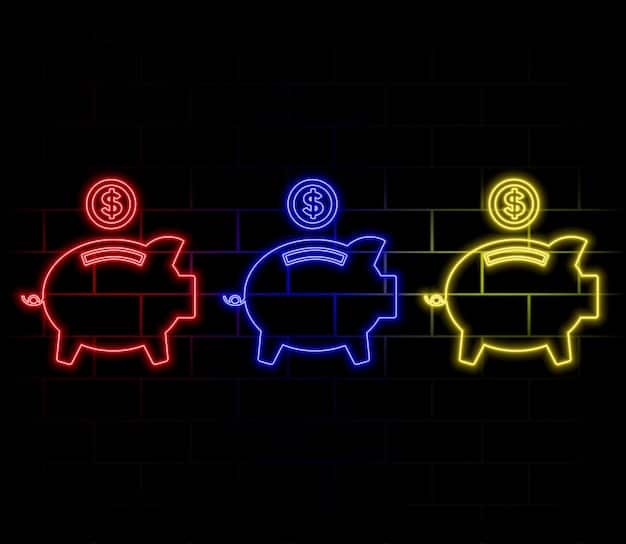Best High-Yield Savings Accounts of 2025: Earn Up to 4.75% APY

Discover the best high-yield savings accounts of 2025, offering APYs up to 4.75% to maximize your savings, ensure financial growth, and reach your monetary goals effectively.
Planning for the future and want to make the most of your savings? Look no further than the Best High-Yield Savings Accounts of 2025: Earn Up to 4.75% APY on Your Savings. These accounts offer a fantastic way to grow your money faster than traditional savings accounts, helping you achieve your financial goals sooner.
Understanding High-Yield Savings Accounts
High-yield savings accounts have become increasingly popular as individuals look for better ways to grow their savings. Unlike traditional savings accounts, these accounts offer significantly higher interest rates, known as Annual Percentage Yield (APY), allowing your money to grow at a faster pace.
What is an APY?
APY, or Annual Percentage Yield, represents the actual rate of return you can expect to earn over a year, taking into account the effect of compounding interest. This differs from the simple interest rate, which doesn’t factor in compounding.
Why Choose a High-Yield Savings Account?
Choosing a high-yield savings account can be a game-changer for your financial future. The increased interest earned compared to traditional accounts can significantly boost your savings over time. Furthermore, these accounts are typically FDIC-insured, providing peace of mind knowing your money is safe and secure.
- Higher Earnings: Benefit from substantially higher interest rates.
- FDIC Insurance: Your deposits are protected by the Federal Deposit Insurance Corporation.
- Accessibility: Easily access your funds when needed.
Ultimately, understanding the benefits of high-yield savings accounts is the first step toward making informed decisions about where to keep your money. As we move into 2025, these accounts continue to be a cornerstone of smart financial planning, offering stability and impressive growth potential.
Top Banks Offering High-Yield Savings Accounts in 2025
Several banks are leading the way in offering competitive high-yield savings accounts in 2025. These institutions stand out due to their attractive APYs, customer-friendly policies, and robust online platforms.

CIT Bank
CIT Bank is consistently recognized for its competitive interest rates and variety of account options. Their high-yield savings account is a popular choice for those looking to maximize their savings potential.
Ally Bank
Ally Bank is another strong contender, known for its user-friendly online interface and excellent customer service. They frequently offer some of the highest APYs on the market.
Marcus by Goldman Sachs
Marcus by Goldman Sachs provides a reliable and secure high-yield savings option backed by a reputable financial institution. Their straightforward approach and competitive rates make them a top pick.
- Competitive Rates: Banks like CIT, Ally, and Marcus consistently offer high APYs.
- User-Friendly Platforms: Easy-to-navigate online and mobile banking.
- Customer Support: Excellent customer service ensures a smooth banking experience.
Selecting the right bank for your high-yield savings account involves considering factors such as APY, fees, accessibility, and customer service. Researching and comparing your options will help you find the best fit for your financial needs and goals.
Key Features to Look for in a High-Yield Savings Account
When evaluating high-yield savings accounts, it’s important to consider several key features that can significantly impact your overall savings experience. These features include APY, minimum balance requirements, fees, and accessibility.
Interest Rates (APY)
The APY, or Annual Percentage Yield, is the most obvious factor. Look for accounts that offer competitive rates compared to the current market average.
Minimum Balance Requirements
Some high-yield savings accounts require a minimum balance to open the account or to earn the advertised APY. Make sure the requirements align with your financial situation.
- No Monthly Fees: Avoid accounts that charge monthly maintenance fees.
- Low or No Minimum Balance: Opt for accounts that don’t require a high minimum balance.
- Easy Access to Funds: Ensure you can easily withdraw your money when needed.
Carefully evaluating these key features ensures you’re not only getting a high interest rate but also an account that suits your lifestyle and financial preferences. Taking the time to compare these elements will help you maximize the benefits of your high-yield savings account.
Maximizing Your Savings with High-Yield Accounts
To truly leverage the benefits of a high-yield savings account, it’s essential to have a clear strategy. This involves setting financial goals, making consistent deposits, and understanding the power of compounding interest.

Set Clear Financial Goals
Define what you’re saving for – whether it’s a down payment on a house, retirement, or an emergency fund. Having specific goals in mind helps you stay motivated and on track.
Automate Your Savings
Set up regular, automated transfers from your checking account to your high-yield savings account. This ensures consistent contributions without requiring constant manual effort.
Understand Compounding Interest
Compounding interest is a powerful tool for growing your savings. The more frequently your interest is compounded, the faster your money will grow.
- Regular Contributions: Make consistent deposits to maximize growth.
- Avoid Unnecessary Withdrawals: Minimize withdrawals to keep your savings compounding.
- Reinvest Interest: Ensure interest earned is reinvested to further amplify compounding.
By setting financial goals, automating your savings, and understanding the power of compounding interest, you can significantly enhance your savings potential with a high-yield savings account. These strategies ensure your money works harder for you, helping you achieve your long-term financial objectives.
Tax Implications of High-Yield Savings Accounts
While high-yield savings accounts offer attractive returns, it’s important to be aware of the tax implications associated with the interest earned. Understanding these implications can help you plan accordingly and avoid any surprises during tax season.
Interest is Taxable
The interest earned on high-yield savings accounts is generally considered taxable income. This means you’ll need to report it on your tax return.
1099-INT Form
Banks typically send a 1099-INT form to account holders who earn more than a certain amount of interest during the year. This form details the amount of interest you’ve earned and need to report.
- Report Interest Income: Accurately report all interest earned on your tax return.
- Consider Tax-Advantaged Accounts: Explore options like IRAs for tax-deferred savings.
- Keep Accurate Records: Maintain records of all interest earned and associated tax documents.
Being aware of the tax implications of high-yield savings accounts is crucial for sound financial planning. By understanding these factors and staying organized, you can ensure accurate tax reporting and optimize your overall savings strategy.
Future Trends in High-Yield Savings Accounts for 2025
As we look ahead to 2025, several trends are expected to shape the landscape of high-yield savings accounts. These include the ongoing impact of economic factors, technological advancements, and evolving consumer preferences.
Rise of Fintech
Fintech companies are increasingly entering the high-yield savings market, offering innovative products and competitive rates. This trend is likely to continue, providing consumers with more options.
Personalized Savings Solutions
Banks are using data analytics to offer personalized savings solutions that cater to individual financial goals and risk profiles. This customization can help individuals maximize their savings potential.
- Competitive Rates: APYs will likely remain competitive as banks vie for customer deposits.
- Enhanced Mobile Banking: Expect improved mobile banking features and user experiences.
- AI-Driven Tools: Artificial intelligence could play a bigger role in helping customers manage their savings.
Staying informed about these emerging trends can help you make the most of high-yield savings accounts in 2025. By embracing new technologies and adapting to market changes, you can position yourself for long-term financial success.
| Key Aspect | Brief Description |
|---|---|
| 💰 High APY | Earn up to 4.75% APY on your savings. |
| 🛡️ FDIC Insured | Your deposits are protected by the FDIC. |
| 📱 Mobile Access | Manage your account easily on the go. |
| 🎯 Savings Goals | Set and achieve specific financial goals. |
Frequently Asked Questions (FAQ)
A high-yield savings account is a type of savings account that offers a higher interest rate (APY) compared to traditional savings accounts. This allows your money to grow faster over time.
Yes, most high-yield savings accounts at reputable banks are FDIC-insured, meaning your deposits are protected up to $250,000 per depositor, per insured bank.
Some high-yield savings accounts may have fees, such as monthly maintenance fees or excessive withdrawal fees. It’s important to review the fee schedule before opening an account.
Interest is typically compounded daily or monthly in high-yield savings accounts. Compounding frequency affects how quickly your savings grow, with daily compounding being slightly more advantageous.
The interest earned on high-yield savings accounts is generally considered taxable income. Banks will usually send a 1099-INT form detailing the amount of interest earned during the year.
Conclusion
Choosing the best high-yield savings accounts of 2025 can significantly impact your financial future by maximizing your savings. By understanding the key features, comparing top banks, and being mindful of tax implications, you can make informed decisions and achieve your financial goals.





